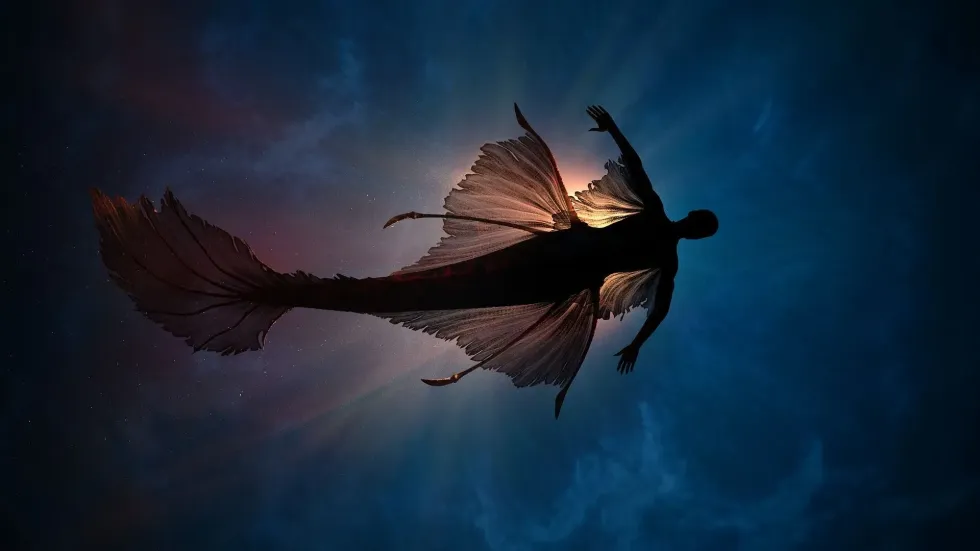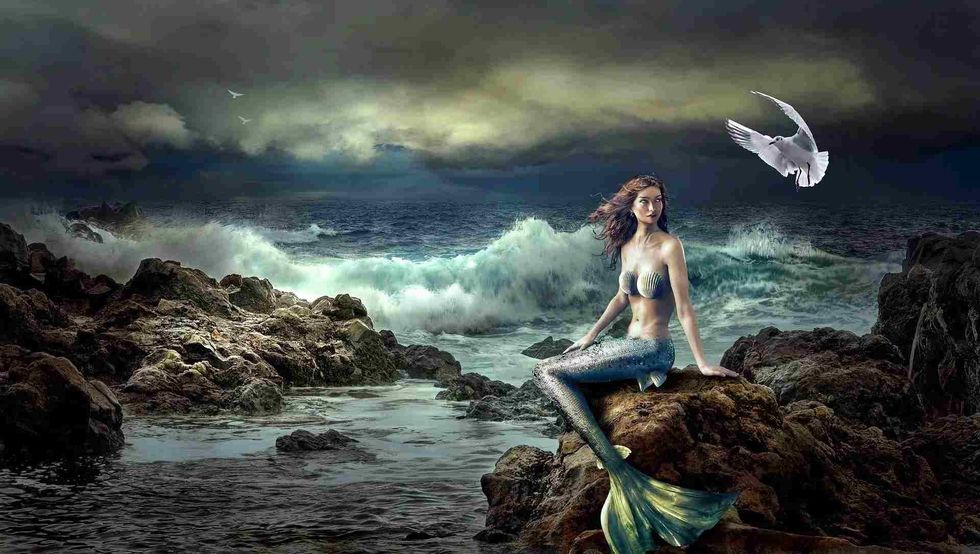181 Mermaid Facts: Do They Really Exist? Find Out

Mermaids, according to folklore, are said to be mysterious creatures from the water with the upper body and head of a female human and the tail of a fish.
In many cultures worldwide, including Asia, Europe, and Africa, mermaids are known to have appeared in folklore. The concept of mermaids was created in ancient civilizations as the personifications of the water deities, as they were the bringers of fertility and life and also as forces of great destruction and nature power.
During the various ancient civilizations, the sightings of mermaids were actually known to be sea cows or manatees. Manatees have mermaid-like characteristics and sailors mistook them for the mythical creatures when seen from afar.
Even Christopher Columbus, the popular explorer, once reported seeing mermaids during his voyage to America. In almost all cultures of the world, mermaids are portrayed as beautiful women with fish-like tails instead of the lower part of the human body.
Long hair and a mesmerizing voice are very commonly associated with this half-human half-fish mythical creature. The myth says that mermaids can hypnotize and sway men with their mesmerizing songs and voice.
A modern view about mermaids was made by the fairy tale about mermaids - 'The Little Mermaid'. Disney's 'The Little Mermaid', based on Hans Christian Anderson's story, is about a young mermaid of the sea wanting to be a part of the human world.
The princess gives up her voice for a chance to stay with the prince in the land of human beings. The original story by Hans did not have a happy ending, but the film made by Disney had a modified story with a happy ending.
It is said that mermaids have the power to become immortal, have telepathy, see the future, and most powerful of all, they can hypnotize human beings. Mermaids are also associated with sirens.
However, sirens are much more dangerous and aggressive. Sirens are given the power of destruction and gather storms in the blink of an eye.
They can lure sailors to their deaths, make ships crash into rocks, bring dense fog, and cause insanity. Sirens come from the Greek myth and are known to be dangerous mythical creatures, always ready for revenge and attack.
Sirens were earlier associated with flying creatures, but the Greek myth of water sirens became very famous all over Europe. Assyrian goddess Astarte, African deity Mami Wata, and Greek Triton and Aphrodite are all famous deities that had the form of mermaids.
All these gods represent beauty, the danger of seduction, fertility, destruction, and the force of nature. Guam's Sirena and Brazil's Iara are the most famous local folklore that depicts the traditional mermaids in all of their magnificence.
Sirens and mermaids play important parts in the mythos involving pirates. When piracy was at its peak, mermaid sightings were also quite high and their stories reached Central America soon.
Mermaid stories say that mermaids are the female members of the race of merfolk that lived underwater. Males of this race are called mermen and are known to be shyer than females.
That is why they are never seen by anyone. Mermen, unlike mermaids, rarely come to the surface of the ocean. Tridents are the most commonly used weapons of the merfolk.
These tridents are made of coral or whalebone, sharp shells, shark teeth, and octopus-ink darts. Mermaids in these stories were always naked, but do have some accessories like crowns, pearl necklaces, hand mirrors, bracelets, combs, and sometimes some musical instruments.
Years after, modern mermaid reports state that there are four main types of mermaids now.
Traditional ones that can only live in the sea, shape-shifting mermaids that have been known to change to the human form when they want, skin-shedding mermaids common in Irish folklore that can walk on the land for short periods of time, and the human form merfolk that can stay on the land and the sea.
The last one has been made popular by the Persian collection of folktales named 'One Thousand and One Nights'.
Mermen came before mermaids as the mermen Babylonian god Oannes came around 7,000 years before Atargatis.
Did you know that mermaids actually mean women of the sea? In the old English language, 'mere' means sea, and 'maid' means woman. There is even a myth that says a mermaid's kiss will help you breathe underwater, maybe even grow gills in you.
It is also believed that the color of the tails of the mermaids depicts their mood. The personality of the mermaid can be determined by looking at her tail.
Now, find more facts about the mysterious mermaids and how they have swayed human perception from hundreds of years ago, and even today.
If you enjoyed this article, why not also read about Nemean lion facts and Hydra Greek mythology facts here at Kidadl?
Fun Facts About Mermaids
Mermaids have always been a source of amusement for many around the world and here are some fun facts regarding these mythical creatures.
The earliest legends of the enchanting creatures come from the goddess Atargatis in Syria. Dating back to 1000 BCE, these were the real mermaid stories. History says that she dove into a nearby lake, but only her lower part was transformed into a water creature. That is why mermaids have half-human half-fish bodies.
There is an ocean gemstone named aquamarine which is believed to come from mermaid tears. Legends say that apart from being part of the treasures, these gemstones coming from mermaid tears had the capability to protect sailors during sea voyages and even when they fell into the water.
There was a perception change in the mind of the people as Disney made a film on the mermaids. 'The Little Mermaid' garnered a lot of interest as it was the first film to portray this mythical creature as a beautiful princess.
You will also see mermaids featured in the movie 'Harry Potter and the Goblet of Fire' and 'Pirates of the Caribbean On Stranger Tides'. In fact, mermaids have featured in over 16 different movies across the world.
Mermaids are now seen in many logos in the commercial world. A water-dwelling herbivorous mammals order called Sirenia was named after the sirens of the open sea. The logo of Starbucks is based on a two-tailed mermaid. Starbuck's original logo art depicted a woman who was either a siren or a Melusine with two tails.
Some say mermaids don't have very good singing voices and that the sirens were the real singers mesmerizing and hypnotizing sailors in those pirate periods.
Sirens and mermaids now are now represented everywhere from media, pop culture, and arts. They are added in fantasy books and stories, songs, and movies and are often written about regularly.
Many people said mermaids looked fat and ugly. This is only because sailors when looked at them from afar thought manatees to be mermaids. Due to this, people for centuries believed mermaids to be fat and ugly. People often forget the beautiful mermaid that has been portrayed throughout history.
Mermaids are probably the coolest of creatures as their kiss can help you take your breath underwater.
They are said to be naturally fearful of fire, though this could be interpreted as a dread of any forms of general warmth, which can cause them to dry out.
Supposing mermaids reproduce the way fish do, mermaid infants would be born by hatching from eggs. Though it is feasible for mermaids to get pregnant and give live birth like dolphins.
Look out for the accessories of the mermaid. It can be anything from pearl necklaces, shell crowns, kelp bracelets, and conch hats. You can also see a mermaid sometimes accessorize its long hair.
Scary Facts About Mermaids
Mermaids are also portrayed as scary beings and sailors were very scared of mermaid sightings.
Mermaids were always considered to be bad luck. If sailors at sea spotted a mermaid in the sea, the voyage was said to head for trouble. However, the tears of a mermaid were said to produce a gemstone called aquamarine and it had the power to protect sailors in the sea.
In the Middle Ages, a mermaid was known to symbolize seduction and sin. Churches used mermaids and even sirens to teach Christians about salvation, sin, and promiscuity.
Sirens, which are often considered related to mermaids, are said to possess extraordinary beauty. But do not go by their beauty and mesmerizing voice as they are deceivers that can sway and hypnotize men.
Sirens will usually use their four superpowers hypnotize, immortality, telepathy, and the power to see the future, to destroy. The powers are the same for mermaids.
History Of Mermaids
There are many historical references to mermaids throughout history.
It is believed that the Babylonian god Oannes came before the Syrian mermaid Atargatis by many thousands of years. Oannes had both a fish body and a human body and his human form was below his fish form.
This allowed him to live with men, and also in the sea. Then came the goddess named Atargatis some around 3000 years ago. The goddess wanted to become a fish and she dove into the water.
But to her surprise, only her bottom part was transformed into a fish's tail. She remained half human and half fish which became the legend of the mermaids.
During medieval times, the existence of mermaids was never questioned.
Some legends from Pacific islands say that humans actually descended from mermen and mermaids.
You will be able to see entities with human upper bodies and fish tails in Mesopotamian artwork from the Old Babylonian Period. Most of these images were mermen, while mermaids were also seen sometimes. Figures were also seen depicted in Neo-Assyrian art as protective figures. The goddess Atargatis comes from this.
In Norman Chapel in Durham Castle, you can see the earliest surviving depiction of a mermaid in England. The chapel was built around 1078 BCE.
The mermaid depiction can be seen on one of the south-facing capitals above one of the stone pillars. A mermaid was also considered a bad omen telling about a coming disaster.
Many variants of the ballad Sir Patrick Spens show a mermaid talking to the doomed ships in the sea. Mermaids are seen to tell the sailors of the ship that they will never see land again.
Melusine is a freshwater mermaid-like creature talked about in European folklore. The mermaid-like creature is depicted with two fish tails or a tail of a snake.
During the Romanesque time, mermaids were considered to be associated with lust.
Byzantine Greece saw the concept of a siren as a mermaid-like creature and also a bird-like creature for quite some time. The illustration of the siren was switched with a mermaid in the Physiologus in the ninth century, while in the Byzantine Greek dictionary of the 10th century Suda preferred the avian variant.
In Southeast Asian culture, a mermaid princess tries to spoil the plans of Hanuman to build a bridge to Lanka. However, she falls in love with him. This theory is seen in the Thai and Southeast Asian versions of Ramayana. This mermaid princess is Suvannamaccha, a daughter of Tosakanth. She is referred to as Sovanna Maccha in Cambodia.
There are many other instances in many different cultures that talk about mermaids.

Facts About Mermaid Sightings
Throughout history, there have been many mermaid sightings reported. However, no evidence of aquatic humanoids has ever been found. Additionally, realistically merfolk would look more like fish than people (as they live in the ocean).
There were hundreds of accounts of mermaid sightings and everything was documented. The mermaid was put normally along with other sea creatures like whales and fishes. The sea maidens were a regular occurrence in the sea that sailors often encountered.
Christopher Columbus documented his sighting of a mermaid. He said the mermaid he encountered was not as beautiful as folklore suggests and had a masculine face. He probably saw a manatee or a dugong.
Captain John Smith of Jamestown said he saw a mermaid that was graceful and attractive. It is not known if it was just a writer's word or if there is any truth behind it.
Edward Teach, an English pirate also known as Blackbeard, was known to steer clear of an area in the sea where he believed merfolk lived. He did this when he sailed across the waters of the West Indies. Even one of the most notorious pirates feared mermaids.
There are professional mermaids now for you to see. Linden Wolbert is a professional mermaid who travels the world as a full-time worker. She is from Los Angeles and she possesses the world's most expensive mermaid tail, the hydro-dynamic tail weighing around 35 lb (16 kg).
Here at Kidadl, we have carefully created lots of interesting family-friendly facts for everyone to enjoy! If you liked our suggestions for 181 Mermaid facts: do they really exist? find out, then why not take a look at Hercules facts or Pan Greek god facts.
We Want Your Photos!
More for You
Bachelor of Arts specializing in English

Ritwik BhuyanBachelor of Arts specializing in English
A skilled content writer, Ritwik holds a Bachelor's degree in English from Delhi University. He has refined his writing abilities through his past experience at PenVelope and his current role at Kidadl. In addition to his proficiency in writing, Ritwik has pursued his passion for flying by achieving CPL training and becoming a licensed commercial pilot. This diverse skill set highlights his commitment to exploring multiple fields. Ritwik's experience in the aviation industry has provided him with a unique perspective and attention to detail, which he brings to his writing.
Bachelor of Commerce

Niyati ParabBachelor of Commerce
With a background in digital marketing, Niyati brings her expertise to ensure accuracy and authenticity in every piece of content. She has previously written articles for MuseumFacts, a history web magazine, while also handling its digital marketing. In addition to her marketing skills, Niyati is fluent in six languages and has a Commerce degree from Savitribai Phule Pune University. She has also been recognized for her public speaking abilities, holding the position of Vice President of Education at the Toastmasters Club of Pune, where she won several awards and represented the club in writing and speech contests at the area level.
Disclaimer
1) Kidadl is independent and to make our service free to you the reader we are supported by advertising. We hope you love our recommendations for products and services! What we suggest is selected independently by the Kidadl team. If you purchase using the Buy Now button we may earn a small commission. This does not influence our choices. Prices are correct and items are available at the time the article was published but we cannot guarantee that on the time of reading. Please note that Kidadl is a participant in the Amazon Services LLC Associates Program, an affiliate advertising program designed to provide a means for sites to earn advertising fees by advertising and linking to Amazon. We also link to other websites, but are not responsible for their content.
2) At Kidadl, we strive to recommend the very best activities and events. We will always aim to give you accurate information at the date of publication - however, information does change, so it’s important you do your own research, double-check and make the decision that is right for your family. We recognise that not all activities and ideas are appropriate for all children and families or in all circumstances. Our recommended activities are based on age but these are a guide. We recommend that these ideas are used as inspiration, that ideas are undertaken with appropriate adult supervision, and that each adult uses their own discretion and knowledge of their children to consider the safety and suitability. Kidadl cannot accept liability for the execution of these ideas, and parental supervision is advised at all times, as safety is paramount. Anyone using the information provided by Kidadl does so at their own risk and we can not accept liability if things go wrong.
3) Because we are an educational resource, we have quotes and facts about a range of historical and modern figures. We do not endorse the actions of or rhetoric of all the people included in these collections, but we think they are important for growing minds to learn about under the guidance of parents or guardians.







